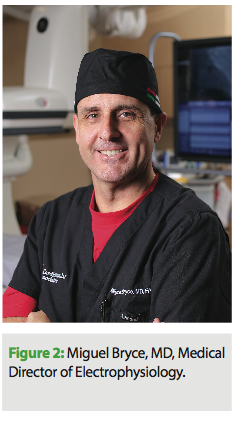ADVERTISEMENT
Implementing New EP Technology: Considerations at Florida Hospital Waterman
In this article we speak with Miguel Bryce, MD, Medical Director of Electrophysiology, about Florida Hospital Waterman’s recently upgraded shared cardiac cath/EP laboratory and upcoming second lab.
When were EP services introduced at your institution?
When I started the EP program at Florida Hospital Waterman in 2002, it was the first EP program in Lake County. Since then, Florida Hospital Waterman has been the leading EP program in the county.
How many staff members do you currently have?
Our lab at Florida Hospital Waterman has 20 staff members, with some specializing in EP cases. We usually utilize two EP-experienced CVTs and RNs for sedation.
How many and what types of EP procedures does your cardiac program perform annually?
We perform EP studies, pacemaker implants, defibrillator implants, loop recorder implants, and ablations for SVT, AV nodal and atrial flutter. We also implant the new injectable loop recorder as well as the subcutaneous ICD. The total number of EP cases performed is around 600-800 per year.
year.
What prompted the need for renovations and for the building of a second lab?
The lab upgrade was necessary in order to provide additional services with more state-of-the-art technology. The first lab, which opened with the new technology in February, now has a new X-ray system, a new table with accessories, larger display monitors, new computers with improved technology, and upgraded equipment. This technology is more efficient and safer for the staff and patients, as it reduces radiation exposure and allows for more integrated technology. With the expansion in population in Lake County, there has also been an increased volume of about 35% of patients requiring EP services.
What key considerations were taken into account when renovating the existing lab?
One purpose of the renovations was to accommodate the growth in our volume and service lines. The improvements will help increase efficiency and reduce radiation exposure to patients, physicians and staff. The images from the new technology are also clearer. A hemodynamic monitoring system for vital signs has also been added.
Tell us about the additional lab that will be opening.
The second lab should be completed by the beginning of October 2014. It will be located next to the existing lab, sharing a control room. When the new lab is completed, both labs will have the same capability to do cath and EP cases, and both rooms will share the volume of the cases when needed. This will allow for flexibility and availability of cases. Lab 1 has been and will primarily be used for EP. In total, both labs combined will be approximately 2000 square feet.
primarily be used for EP. In total, both labs combined will be approximately 2000 square feet.
Tell us about some of the new technology included in the upgraded lab and upcoming second lab.
The new lab will have brand-new GE equipment, including the procedure table, X-ray equipment, and a large flat-screen display monitor with the capability of uploading images from prior studies for real-time comparison. This new system is fully integrated and enables St. Jude Medical’s EnSite Velocity System to be displayed on a 60-inch display monitor, allowing better precision and accuracy in ablations (we perform about 60-100 ablations per year).
How have the renovations affected workflow in your cardiac program?
The new lab utilizes the Unfors RaySafe radiation monitoring system, which provides staff with a continuous and immediate reporting of radiation exposure; this allows immediate action to be taken compared with a delayed reporting system.
What do you think are the best features of the newly renovated lab?
Having access to clearer images on the monitor when performing ablations, as well as having less radiation exposure when implanting cardiac rhythm management devices, are definitely the best features.











